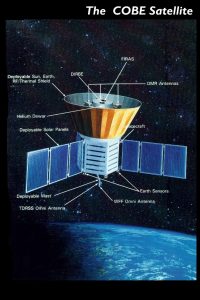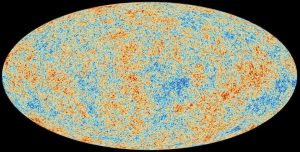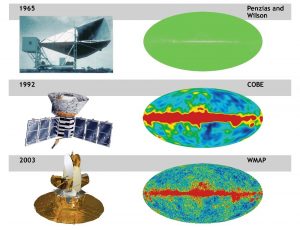Do you know that snowy screen you get on your television when you are between two channels? It’s just fuzzy white noise and it always made your fingers staticky when you moved them across the screen. Did you ever wonder what that actually was, or what caused it?

The answer isn’t as mystical as anything your childhood self may have imagined, but it is still really cool.
That static that you can see on your television at home is caused by something that has been around since the beginning of the universe – the CMB.
Before we delve into the history behind the CMB, it’s first important to understand exactly what it is.
What does CMB stand for? Why is it important?
Why do we care?
Well, CMB stands for the Cosmic Microwave Background, which is… exactly what it sounds like. The CMB is a constant and isotropic radiation in the microwave range of the electromagnetic spectrum that fills the background of our cosmos.
But… where did it come from?
That is a more interesting question. In order to define exactly how the CMB was born, we need to go back in time a little. And by a little, I mean a lot. Back about 13.8 billion years ago, when the universe was but a young babe.
When the universe was newly forming, it was extremely hot and dense. By “extremely hot”, though, we don’t just mean a couple of thousand Kelvin. We mean 109 Kelvin. A billion Kelvin. At such high temperatures, the baryonic matter (meaning protons and neutrons) in the universe was able to be fully ionized, and the free electrons rendered the universe opaque.
Does that ring any bells? A dense, hot, and opaque body?
Well, if you didn’t know, a hot, dense, and opaque body is what produces blackbody radiation!
Now, as the universe began to expand, it also began to cool down. About 380,000 years after the big bang, the universe was eventually able to be cooled to a temperature where electrons could begin to recombine with baryonic matter to form atoms. In doing this, the rate of photon scattering was, inevitably, lowered.
Now at some point, photons ceased to scatter at all and began to travel freely through the universe. There is a “surface of last scattering” that is known, which is when these CMB photons last hit any type of matter in the universe. After that last scattering, the universe just became too large for these photons to hit anything.
These photons are what we are learning about, because they are what we see today as the CMB!
Now, just a bit of modern history about the CMB
The CMB was first “discovered” by Arno Penzias and Robert Wilson when they had found a stronger-than-expected signal whilst conducted radio astronomy. (Discovered is in quotes as they weren’t technically the first to discover it, Ralph Alpher and Robert Herman predicted its existence in 1948). They had first believed the stronger signal was due to noise in their readings, but after trying to reduce this noise through… interesting means, they found that it had remained despite their efforts.
From the American Physical Society – “Then they found droppings of pigeons nesting in the antenna. They cleaned out the mess and tried removing the birds and discouraging them from roosting, but they kept flying back. “To get rid of them, we finally found the most humane thing was to get a shot gun…and at very close range [we] just killed them instantly. It’s not something I’m happy about, but that seemed like the only way out of our dilemma,” said Penzias. “And so the pigeons left with a smaller bang, but the noise remained, coming from every direction.””
Now, they had observed this CMB at a wavelength of 7.35 cm, which means that they were only seeing the CMB photons that had an energy of 0.027 times the mean photon energy. Turns out, however, that any CMB photon equal to or below around 3 cm wouldn’t be able to be detected very easily from the surface of earth, as they are very easily absorbed by water molecules.
Yet!
This can be avoided by taking measurements from satellites outside of the earth’s orbit. Which is exactly what NASA did.

In November of 1989, NASA launched COBE (Cosmic Background Explorer) whose mission was to take measurements of the CMB ranging from 1 micrometer to 1 cm over the entirety of the celestial sphere. By the end of its mission, the CMB spectrum was measured with a precision of 0.005%. Overall, it provided evidence that the CMB has a spectrum near perfect that of a blackbody, and showed that it has faint anisotropies. (An antisotropy is pretty much the opposite of isotropy – it’s the property of being dependant on direction. The anisotropies in the CMB are what make the images appear “staticky”)
In 2001, the Wilkinson Microwave Anisotropy Probe (WMAP) was launched. The duration of the mission was 9 years, and it led to some pretty amazing discoveries about our universe. Not only was WMAP able to show that the Local Group is moving in the direction of Hydra (which will be touched upon further after), but the team was also able to identify (to a very high accuracy!) the age of the universe and the density of atoms.
But wait, there’s more!
Last but certainly not least, there is the Planck satellite. This bad boy was launched in 2009, and orbited the second Lagrange point, about 1.5 million km away from earth. Planck had a higher sensitivity and resolution than WMAP and had four more frequency bands (for a total of 9!).

In 2013, the research team released an all-sky map of the CMB, which changed our understanding of the age of the universe. Turns out, it is a bit older than we had originally thought. The map shows that there were fluctuations in the temperature when the universe was about 370,000 years old. The age, as they determined, is 13.798×109 years old. There were also a bunch of other constants and information that they had measured, but I will not be touching upon these. If you are interested, feel free to look here.

There was more data released in 2015, which pretty much agreed with data collected by WMAP, but found within less error. They also confirmed the universe to have 26% content of dark matter.
Now, back to the fun part about the Local Group moving.
In its collection of data, WMAP found a dipole distortion in the temperature. Interestingly, this is just a Doppler shift! But it is in using this that we can correct this data using a wad of other numbers (more specifically, the orbital motion of WMAP around the sun, the orbital motion of the sun around the galactic centre, and the orbital motion of our galaxy relative to the centre of mass of the Local Group), and thus can find the velocity of us (the Local Group) moving! This velocity is around 630 km/s, and it is in the general direction of the constellation Hydra.
It is also possible to find the mean temperature of the CMB after this anomaly (being the dipole distortion) is subtracted, which is about 2.7255 K. The temperature fluctuations can also be determined at any given point.
The equation that gives us this mean temperature?
![]()
The equation that gives is the temperature fluctuations?

Where T(θ,φ) is the temperature of the CMB at a given point on the sky.
Well, you ask yourself, why is any of this important at all?
Because, dear reader, these observations support the Hot Big Bang model of our universe! In fact, the existence of the CMB is what caused the Big Bang model for the universe to be favoured over that of the Steady State model in which a background radiation of 2.7255K is not easily explained. In the scenario of a Hot Big Bang, nearly isotropic background radiation is perfectly normal seeing as the universe would have had to have been hot and dense.
What does the CMB offer for our future, though?
Well, there are plenty of experiments that are currently active that revolve around the CMB and understanding it further. A comprehensive list can be found here (of both past and present experiments), if you are interested!
What will we do with this data, though? Well, pretty much what we have been doing. With all the information that we have gathered about the CMB, hopefully, we will be able to further understand the nature of our universe! As has already been done, hopefully we will be able to learn, in greater detail, about the birth of our universe and everything that has happened since.
Although the cosmic microwave background may seem like, well, just background information, it has been (and always will be) invaluable in our understanding of our cosmos.
Now, if you want a quick refresher on everything that you just learned, there is an infographic from SPACE.com that sums it all up beautifully. (I tried to include it here, but the quality is so much worse than anything you could imagine.
If you’re still looking for a bit more understanding, a video that I found very helpful is one by SciToons. It is about 6 minutes long, but the visuals and ease of understanding make it worth it, I promise!
If you still have questions, feel free to reach out to me! I am by no means an expert on the subject, but I am confident that I will be able to help (at least a little).